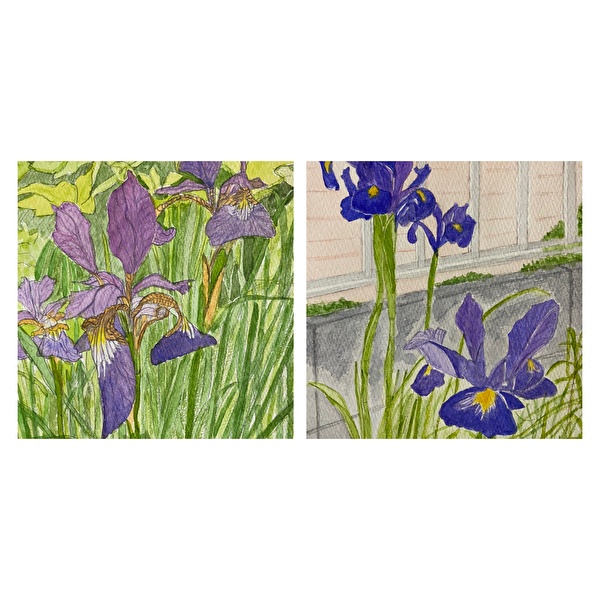Ayame (Iris sanguinea) bloomed in the garden of my parents’ house and Dutch iris (Iris hollandica) bloomed in my garden in early May. Both were so beautiful that I drew and painted them. They are very similar but I could find the difference because I sketched them carefully.
I remembered a Japanese proverb “Izure Ayame ka Kakitsubata?” This proverb means that Ayame and kakitsubata are so similar that it is difficult to distinguish between them, meaning that both are excellent and difficult to be compared. Ayame (iris sanguinea) blooms purple flowers in early May. It is characterized by a yellow and white mesh pattern at the base of the outer petal. They grow in colonies in dry places like fields and meadows.

On the other hand, Kakitsubata (iris laevigata) is characterized by a white streak at the base of the outer petal. The color of their petals is deep purple and they grow in colonies in wetlands in mid-May. I didn’t see them in my neighborhood so I looked for a picture on the Internet. I could see the difference, but indeed they are both incomparably beautiful.

The Ayame festival is held in every region of the country in June every year in Japan. That Ayame usually refers to Hanashoubu (Iris ensata). It is said that the name “Hanashoubu” comes from the resemblance of its leaves to those of Shoubu (sweet flag) and it blooms flowers. Hanashoubu is a horticultural variety of Nohanashoubu (Iris ensata var. spontanea) that grows wild in the fields and marshlands of Japan. Since the middle of the Edo period (1603-1868), breeding has been actively carried out. Hanashoubu is very similar to Ayame and Kakitsubata, but it comes in a wide variety of colors, shapes and sizes of flowers. They bloom from early to mid-June.

Close to me, I often see Kishoubu (Iris pseudacorus) blooming along a small stream while I take a walk in my neighborhood in this season. They are a very eye-catching bright yellow. Kishoubu is the same type of Hanashoubu, but it is a foreign species that comes from Europe, so it is common that we call it Kishoubu separately.

Ichihatsu (Iris tectorum) is also similar to Ayame. Ichihatsu is native to China and came to Japan in the Muromachi period (1336-1573). It is said that they were called Ichihatsu because they bloom first among flowers of the Iridaceae family around April. It is characterized by the presence of a crest-like white projection at the base of the outer petal.

Dutch iris (Iris hollandica) is bulbous iris improved in the Netherlands. It is possible to grow it comparatively easily though it likes slightly dry places, it is strong in the cold. It is often grown in Japan. So they grow in my garden.

German iris (Iris germanica) was made by complex mating on the basis of natural hybrid, Guernica, which is native to Europe. They have been made in Germany and France from the 1800s and their breeding have been advanced in America now. They are the most gorgeous flowers of the Iridaceae family and have so many varieties. It is characterized by the hair that is dense like a brush at the base of the outer petal.

Speaking of Shoubu (sweet flag), it is a fragrant grass which is used for Shobuyu for Tango-no-sekku. Shobuyu is the bathwater heated with sweet flag roots and leaves in it. The flower of Shoubu is in the shape of an ear and they grow in colonies in the waterside such as swamps and ponds. Shoubu is a member of the Araceae family.

In the old days, people used to call Shoubu “Ayame” or “Ayamegusa.” And they used to call Ayame “Hanaayame” because Ayame has similar leaves as Shoubu. All flowers I introduced this time are a member of the Iridaceae family and different from Shoubu of the Araceae family, but Hanashoubu of the Iridaceae family is called Shoubu. If you write “Ayame” and “Shoubu” in kanji, you can write the same kanji “菖蒲.” It is so confusing.
My interest in Ayame and Dutch iris led me to learn many things about flowers of the Iridaceae family. If I see a flower of the Iridaceae family, just knowing what it is seems to add to my enjoyment.
5月初旬に実家の庭にアヤメが咲き、自宅の庭にはダッチアイリスが咲きました。とても綺麗だったので絵に描いてみました。良く似ていますが描いてみるとはっきりと違いがわかります。
「いずれ菖蒲か杜若(いずれアヤメかカキツバタ)」という日本のことわざを思い出しました。アヤメとカキツバタがどちらも似ていて区別がつきにくいところから、どちらも優れていて優劣つけにくいことを意味することわざです。アヤメは5月上旬に紫色の花を咲かせます。外側の花びらの根本に黄色と白の網目模様があるのが特徴で、畑や草原など乾燥した場所に群生します。
一方、カキツバタは外側の花びらの付け根に白い筋があるのが特徴です。花の色は濃青で5月中旬に湿地に群生します。カキツバタは近所では見られなかったのでネットで写真を探しました。違いはわかりましたが、確かにどちらも優劣つけ難い美しさです。
毎年6月になると日本全国各所で「あやめ祭り」が開催されます。その「あやめ」はたいてい花菖蒲(ハナショウブ)のことを指します。ハナショウブの名前は、葉がショウブに似ていて花を咲かせることからハナショウブと呼ばれるようになったと言われています。ハナショウブは日本の野原や湿原に自生しているノハナショウブの園芸品種で、江戸時代中期頃から盛んに品種改良が行なわれてきました。花はアヤメやカキツバタと非常に似ていますが、花の色や形や大きさの種類が豊富です。6月初旬から中頃に咲きます。
身近なところでは、この時期に散歩をすると小川のそばでキショウブが咲いているのを見かけます。とても鮮やかな黄色で目を引きます。キショウブはハナショウブの仲間ですが、ヨーロッパ原産の帰化植物で外来種なので独立してキショウブと呼び分けるのが普通だそうです。
イチハツもアヤメに良く似ています。中国原産で日本へは室町時代に渡来しました。4月頃アヤメ科の花の中で一番早く咲くという意味からイチハツ(一初)と呼ばれるようになったと言われています。外側の花びらの付け根に白色のとさか状の突起があるのが特徴です。
ダッチアイリスはオランダで改良された球根タイプのアイリスです。やや乾燥した場所を好みますが、寒さにも強く比較的栽培が簡単なため、日本でもよく栽培されています。というわけで我家の庭でも栽培しています。
ジャーマンアイリスはヨーロッパに野生する自然交雑種ゲルマニカをもとに複雑な交配により作られたものです。1800年代からドイツ、フランスで作られ、今ではアメリカで品種改良が進んでいます。アヤメ科の花の中では最も華やかで、非常に多くの品種があります。外側の花びらの付け根にブラシのように毛が密生しているのが特徴です。
ショウブと言ったら端午の節句に菖蒲湯にする香りの良い草のことです。菖蒲湯はお風呂に菖蒲の葉や根を入れたものです。ショウブの花は穂の形をしていて池沼やため池など水辺に群生します。ショウブはサトイモ科です。
昔はショウブのことをアヤメとかアヤメグサと呼び、アヤメのことをショウブと似た葉を持つことからハナアヤメとも呼びました。今回紹介した花は全てアヤメ科で、サトイモ科のショウブとは別物ですが、花菖蒲(ハナショウブ)はショウブと呼ばれています。漢字で書けばショウブもアヤメも「菖蒲」と書くので全く紛らわしいです。
アヤメやダッチアイリスに興味を持ったことがきっかけで、アヤメ科の花についていろいろと知ることができました。アヤメ科の花を見かけたらそれが何であるのかがわかるだけで楽しみが増えたように思います。
Ikuyo.K.
RECENT POSTS

